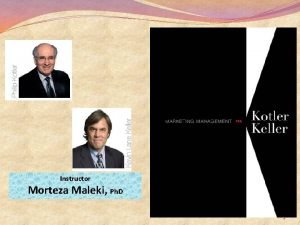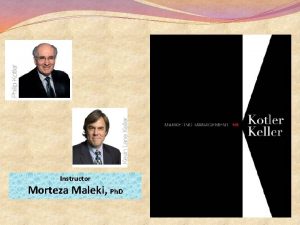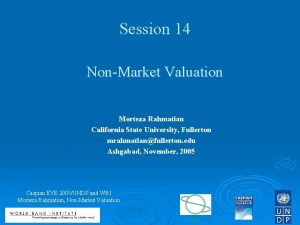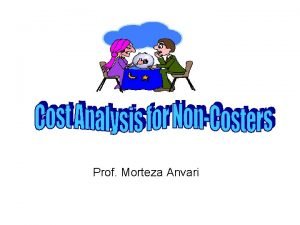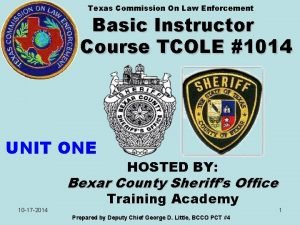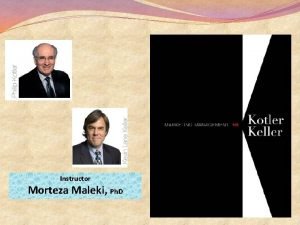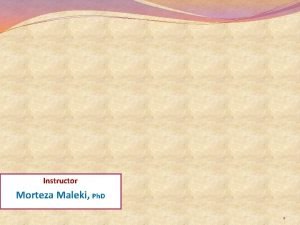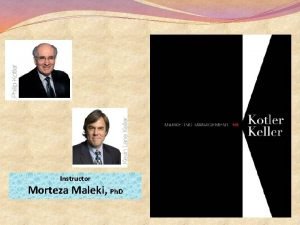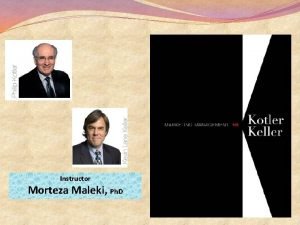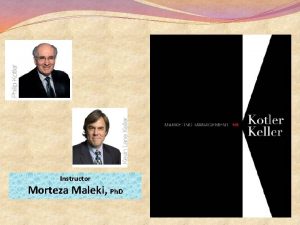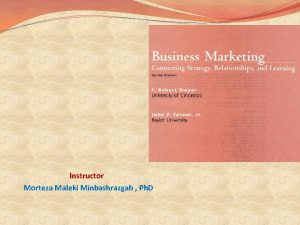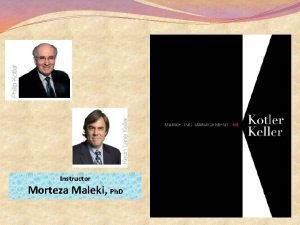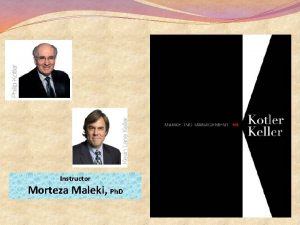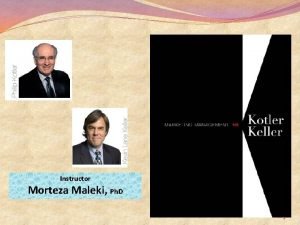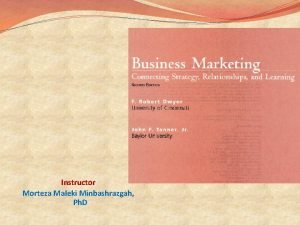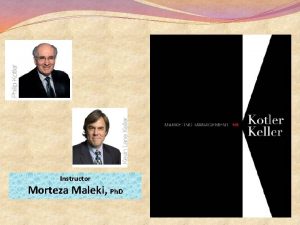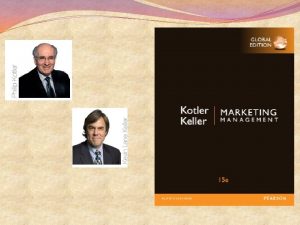Instructor Morteza Maleki Ph D The nature of















































- Slides: 47

Instructor Morteza Maleki, Ph. D


The nature of Professional Selling Salespeople create value ü Salespeople add value by identifying customer needs and devising or delivering a solution for those needs. ü They are able to adapt or change how a product is presented or even able to adapt the product itself so that it meets the needs of the buyer. ü Such adaptation powers professional selling, because customers often don’t know what they need or how to configure a solution for their needs.

The nature of Professional Selling Professional Salespeople are Ethical ü The nature of professional selling in the business – to – business environment supports and encourages ethical behavior. ü Taking a sales job in the business marketing environment does not mean that a compromise of personal values will be necessary to be successful.

Sales’ Role in the Organization ü The field sales force is responsible for managing the personal relationship between the company and the customers. ü Salespeople bring dialogue to the life. ü Salespeople have further responsibilities: 1. 2. 3. Coordinating the firm’s actions in order to satisfy customer requirements and gaining customer information. Sharing that information so that appropriate product, marketing and investment decisions can be made. Salespeople play an important role in product design through early supplier involvement (ESI)

Sales’ Role in the Organization Managing Relationships ü Salespeople have the field responsibility of deciding which accounts to work with and which accounts to bypass. ü They also has the responsibility of determining specific account strategy. ü They are further responsible for implementing the account strategy and ensuring customer satisfaction. 1. Creating Customers for Life 2. Customer Service 3. Coordinating Corporate Resources

Sales’ Role in the Organization Gathering Information ü Successful learning organizations gather, share, and act on information. ü Boundary spanning positions are important information gathering and sharing positions. ü Sales and purchasing = two important boundary spanning positions. ü Sale’s responsibility is to engage the customer in dialog or two – way communication to achieve mutual interests; ü Salespeople also gather information concerning competitors and market factors. 1. 2. Customer Dialogue Competitor information

Sales Strategies & Customer Relationships Types of Customer Relationships & Selling Strategies ü There are four basic sales strategies that illustrate the potential range of possible strategies: 1. 2. 3. 4. Script – base Selling Needs Satisfaction Selling Consultative Selling, & Strategic Partnering

Sales Strategies & Customer Relationships 1. Script – Based Selling ü Also called canned – selling, it involves using scripts or memorized sales pitches from which the salesperson does not deviate. ü ü It is in use in situations where customers needs do not vary much from one customer to another. The product should be relatively simple and easy to understand.

Sales Strategies & Customer Relationships 2. Needs Satisfaction Selling ü A process of selling that involves identifying the buyer’s needs and tailoring the sales pitch to fit those needs. ü It involves two components: 1. 2. Identifying the needs & Making the presentation ü It works best when there is variance in needs across buyers and choices have to be made among products.

Sales Strategies & Customer Relationships 3. Consultative Selling ü In consultative selling, the seller is bringing specialized expertise into a complex problem in order to create a somewhat customized solution. ü ü It is very similar to needs satisfaction selling, but differs to a matter of degree. When using this method, the solution choices are not simply a matter of choosing from an array of finished products. ü In this method, the salesperson is the consultant; ü More of the knowledge lies with the salesperson than with the customer in comparison to needs satisfaction selling.

Sales Strategies & Customer Relationships 4. Strategic Partner Selling ü Both parties share expertise and resources to create customized solutions, and there is a commitment to join planning for mutual benefit. ü ü ü It requires a commitment of resources well beyond that of just the salesperson and customer support staff. Commitment of the resources in all areas of the firm is required. The results should be a maximization of revenue for all areas of the company.

Sales Strategies & Customer Relationships Selling across the Stages of the Partnership

Sales Strategies & Customer Relationships

Organizing the Sales Force Sales Executives ü Depending on the size of the organization; ü The chief executive officer may fulfill the responsibilities of the sales executives, or ü The marketing executives and sales executives duties may be combined into one position, or ü The sales executive position may be a stand – alone function ü The sales executive is responsible for decisions like, 1. 2. 3. 4. The choice of sales strategy, The number and location of the salespeople, The setting of sales quotas and designing the compensation plans, & Sales forecast.

Organizing the Sales Force Size and Organization of the Sales Force ü The sales executive determines the ü The size of the salespeople, & ü The type of salespeople need. Geographic Salespeople ü The most basic salesforce structure is to give each salesperson all accounts within a specified geographic area. ü Geographic salesforce are used when all products serve the same general types of buyers. ü Two types of geographic salespeople: 1. 2. Outside Salespeople or Field Salespeople Inside Salespeople

Organizing the Sales Force ü When only geographic structure is used, the organization structure is likely to be line and staff. ü Those who conduct the primary tasks of the department (sales) are part of the line – their managers are called line managers – and all support personnel are staff. ü Salesperson’s responsibility for an account comes from the branch sales manager, who received that responsibility from the regional manager, who get it from the sales executive.

Organizing the Sales Force ü Companies may also organize their salespeople by account. ü The account salesperson has responsibility for specified accounts, rather than a geographic area. ü Similar customers often have similar needs, whereas different types of customers may have very different needs for the same product. ü In such cases, salespeople may specialize on one type of account.

Organizing the Sales Force ü Companies also divide their accounts on the basis of size; ü Large customers – key accounts – may have salesperson assigned only to their accounts. ü The salesperson is called a Strategic Account Manager (SAM). ü A house account is handled by a sale executive and the company does not pay anyone commission on sales from the account.

Organizing the Sales Force Product Specialist ü When companies have diverse products using different technology platforms, their salespeople will specialize by product category. ü The need for technology expertise is too great for any one salesperson to understand, so the salesperson is organized by products.

Organizing the Sales Force Sales Team ü In team selling, a group of salespeople handle a single account, each salesperson brings a different area of expertise or handles different responsibilities. ü ü One type of team is the field salesperson and telemarketing support rep. Another type of team is used in multilevel selling, where members of a selling organization at various levels call on their counterparts in the buying organization.

Organizing the Sales Force

Organizing the Sales Force ü The customer-focused team (CFT) is a structure that assigns customer responsibility to individuals across the organization, in sales and in other areas. ü The structure resembles a wheel, with the customers as the hub. ü In addition to product specialists, the account manager can draw on the expertise of a specific credit manager, a specific billing person, someone in manufacturing, and so forth. ü They are part of the account strategy development process and are headed up by the account manager. ü These individuals will also have line managers (someone in charge of all manufacturing).

Organizing the Sales Force

Organizing the Sales Force Size ü One approach to determining the optimum number of salespeople involves an analysis of the salesperson’s workload ü All of the activities that a salesperson must do to cover a territory.

Organizing the Sales Force ü The desired number of calls per account will depend on a number of factors, including: 1. 2. 3. 4. The sales strategy selected. The type of salesperson (geographic, account specialist, etc. ). The nature of sales job. The nature of the product. ü 5. Stage of market development. ü 6. More complex products require more calls. A company entering a market has few customer service requirements and can use large territories. Competitive intensity. ü As intensity grows, so may the number of sales calls.

Organizing the Sales Force Sales Resource Allocation Grid ü A method to determine the salesforce workload, focusing on two things: 1. ü ü 2. ü Market Position It means the strength of the company relative to competitors, measured by market share, but should also reflect forecasts of future share. If a competitor has just introduced a new product that will capture a significant share of the market, it is foolish to consider only your current share. Sales Potential It is the total forecasted sales for the product category.

Organizing the Sales Force By determining the number of accounts in each quadrant and multiplying that by the desired number of calls each account of that type should receive, a sales manager can calculate the total number of sales calls, and ultimately, salespeople, needed.

Organizing the Sales Force Outsourcing the Salesforce ü Manufacturers’ reps, distributors, and telemarketing service bureaus can fill the requirement for salespeople without the fixed costs of hiring your own. Advantages 1. 2. 3. 4. Costs Relationship already existed Fast penetration into New Markets Less up-front Investment Disadvantage ü Loss of Control

Directing the Salesforce ü Part of the sales executive’s responsibility is to ensure that the salespeople are working to achieve the company’s sales and customer service objectives. ü Field salespeople are scattered over a wide area and operate without benefit of direct supervision. ü There are two control strategies: 1. Quotas, 2. Compensation plans

Directing the Salesforce Quotas ü Quotas represent a quantitative minimum level of acceptable performance for a specific time period. ü Quotas are of two types: 1. 2. Activity Quotas, & Performance Quotas

Directing the Salesforce 1. Activity Quotas ü It specifies the number and type of activities that salespeople should do. ü It is useful in situation where the sales cycle is long and sales are few, because activities can be monitored more frequently than sales. ü It can be specified for many types of sales activities : ü ü ü Number of current customer calls Demonstrations, Proposal presentations, etc.

Directing the Salesforce 2. Performance (Outcome) Quotas ü It specifies levels of performance, such as revenue, gross margin, or unit sales in a period of time. ü Gross margin quotas, for example, can be used to encourage salespeople to sell profitable products, not just the products that may be the easiest to sell.

Directing the Salesforce Compensation ü The salesperson needs an equitable, stable compensation system, but the company needs a system that encourages profitable sales and customer satisfaction.

Directing the Salesforce Sound compensation programs 1. 2. 3. 4. Base rewards on results and efforts Provide equal rewards for equal performance Provide competitive rewards Are easy to understand implement

Directing the Salesforce Types of Sales Compensation 1. Straight Salary ü A salesperson is paid a fixed amount of money for work during a specified time. ü A quota system may be used to determine annual salary raises, but otherwise pay does not vary. ü It is best used when 1. Sales cycles are long, 2. A team of people is involved and individual results are difficult to measure, 3. Other aspects of the marketing mix (such as advertising) are important to closing the sale.

Directing the Salesforce 2. Straight Commission ü A straight commission plan pays a certain amount for each sale, but there is no salary. ü The commission base, or the item from which the commission is determined, is usually unit sales, dollar sales, or gross margin. ü The commission rate is the amount paid per base item sold, and is usually a percentage (such as 10 percent of sales revenue or gross margin) or a fixed amount (such as $50 per sale).

Directing the Salesforce Draw ü A draw is a loan paid to the salesperson to provide stable cash flow; it’s then repaid from commission. ü Straight commission ties pay directly to performance, but does little to engender company loyalty. ü Salespeople on straight commission are far less likely to do activities that they don’t see tied directly to making a sale, activities such as paperwork, sales forecasts, and even customer service.

Directing the Salesforce 3. Bonus ü Bonuses resemble commissions, but it is a lump sum payment for meeting a minimum standard of performance within a given period of time. ü The amount depends on total performance, not an individual sale. ü Bonuses motivate salespeople to overachieve quotas and can be used in conjunction with either commission or salary or a combination plan. ü A salesperson who has made quota with three months left in the year can be motivated to sell even more if a bonus is worthwhile. ü Salespeople can earn bonuses based on customer satisfaction ratings, total sales revenue, and revenue growth over the previous year.

Directing the Salesforce 4. Combination Plans ü Also called salary plus plans, they pay salary plus a commission or plus a bonus. ü The salary portion can engender loyalty to the company and represent pay for activities that benefit the company more than the salesperson, whereas the commission or bonus portion can motivate the salesperson. ü It is used when management wants long-term customer relationships and when teams are used.

Directing the Salesforce Disadvantage ü They can become very complex; Confused salespeople may unknowingly engage in inappropriate activity. Advantage ü Compensation plans affect the choice of where salespeople place their effort; good compensation plans encourage effort in the right activities ü Companies sometimes cap earnings for their salespeople. ü A cap is a limit to how much a salesperson can make, no matter what the amount of sales. ü Caps can be unethical if salespeople are unaware of them.

Evaluating Performance ü Sales executives are concerned both with total sales revenue as well as sales productivity. Five Steps to Evaluating Sales Force Performance

Evaluating Performance Sales performance is measured in two ways: 1. Outcome Measures records performance concerning important results such as sales volume, total revenue, total profit contribution, number of new customers, and increase in sales from old customers. ü It ü These numbers can be compared to performance or outcome quotas to determine if goals were met.

Evaluating Performance Effort Measures 2. ü Since External factors, new products, and other issues can make performance look stellar or terrible in spite of anything the salesperson does, sales executives also measure activity, or a salesperson’s effort.

Evaluating Performance Measuring Productivity ü When the measures of effort and output are combined, the sales executive can examine the efficiency of the salesperson or sales force.

Evaluating Performance Balanced Performance ü In addition to examining the productivity or output of individual reps, the sales executive must also examine the productivity of the overall sales force in order to make such decisions as quantity discounts and deleting products from the product line. 1. 2. 3. Average order size, Order mix (which products are purchased with other products), and Sales by product

The End
 Morteza maleki
Morteza maleki Example of data gathering procedure
Example of data gathering procedure Insertion sort pseudocode
Insertion sort pseudocode Morteza farajian
Morteza farajian Morteza rahmatian
Morteza rahmatian Morteza farajian
Morteza farajian Morteza anvari
Morteza anvari Morteza farajian
Morteza farajian Morteza
Morteza Isaep model
Isaep model Morteza anvari
Morteza anvari Nature and nature's laws lay hid in night meaning
Nature and nature's laws lay hid in night meaning Determinace lidské psychiky
Determinace lidské psychiky Instructor
Instructor Usmc jrotc vacancies
Usmc jrotc vacancies Basic instructor course texas
Basic instructor course texas Basic instructor course texas
Basic instructor course texas Delmar cengage learning instructor resources
Delmar cengage learning instructor resources Medical terminology instructor
Medical terminology instructor Nra certified instructor logo
Nra certified instructor logo Basic instructor course tcole
Basic instructor course tcole Human factors instructor
Human factors instructor Instructor vs teacher
Instructor vs teacher Tcole advanced instructor course
Tcole advanced instructor course How to become an nrp instructor mentor
How to become an nrp instructor mentor Basic instructor course #1014
Basic instructor course #1014 Basic instructor course tcole
Basic instructor course tcole Basic instructor course #1014
Basic instructor course #1014 Instructor office hours
Instructor office hours Naismith was an instructor of
Naismith was an instructor of Ac 61-98 plan of action
Ac 61-98 plan of action Instructor operating station
Instructor operating station Ospfv
Ospfv Jrotc marksmanship instructor course online
Jrotc marksmanship instructor course online Utp cable
Utp cable The virtual instructor
The virtual instructor Pepperball hotshot
Pepperball hotshot If your instructor were to ask if you cleaned up your room
If your instructor were to ask if you cleaned up your room Tcole 1014 basic instructor course
Tcole 1014 basic instructor course Catia instructor
Catia instructor Mptc firearms instructor manual
Mptc firearms instructor manual Tcole basic instructor course
Tcole basic instructor course Optical illusion
Optical illusion Tipo de participantes
Tipo de participantes Cbrf registry wi
Cbrf registry wi Nfpa 1403 instructor to student ratio
Nfpa 1403 instructor to student ratio Not only the students but also the instructor
Not only the students but also the instructor Tcole advanced instructor course
Tcole advanced instructor course
